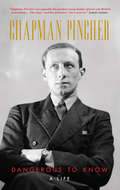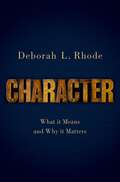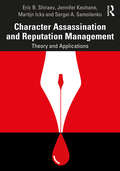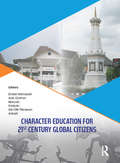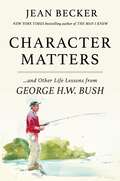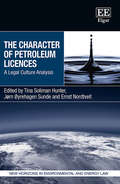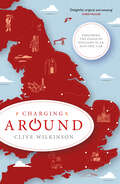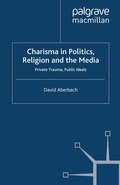- Table View
- List View
Chapman Pincher: A Life
by Chapman PincherHarry Chapman Pincher is a legend among journalists. As an investigative reporter, he struck terror into those trying to hide the murky secrets of state.After early careers as a teacher, a scientist and a soldier, Chapman Pincher joined Lord Beaverbrook’s then all-powerfulDaily Expressin the summer of 1945 - and quickly became the master of the journalistic scoop. His first splash, a top-secret account of the development of the atomic bomb, sparked a furious transatlantic row. It was only the start of a career in which his name became synonymous with high-level exclusives from the most secret corners of government.When he finally retired from journalism, the leaks kept coming, leading to a series of bestselling books on the infiltration of Britain’s intelligence services by Moscow, culminating in his allegation that the head of MI5 was in fact a Soviet spy.InDangerous to Know, Chapman Pincher took pen to paper to describe the extraordinary events he witnessed and the varied characters he encountered. Colourful, indiscreet and compelling, this is the life of a true journalistic colossus and a revealing description of the century he bestrode.
Character: What it Means and Why it Matters
by Deborah L. RhodeAmericans claim to care about character. Over four fifths want it taught in public schools, and 95 percent think that a president's character is important. And historically, philosophers, educators, politicians, religious leaders, judges, and the general public have agreed that character should be valued and reinforced. Yet in the United States, the institutions charged with that mission have consistently fallen short. Simply put, too little effort has been made to understand the importance of character and the strategies that can best develop and support it. After first exploring the history of the concept over time, Deborah Rhode turns her focus to the institutions that have traditionally fostered good character: families, schools, youth organizations, civic groups, and political organizations. However, as we have increasingly de-emphasized the subject-a trend that is most evident in our politics-our awareness of its shaping influence has waned. Indeed, we often focus on the wrong things when it comes to fostering good character. For instance, almost a third of the workforce is covered by licensing laws requiring good moral character, even occupations where the need for screening is not self-evident: florist, fortune teller, and frog farmers. Character also plays a pivotal role in the criminal justice system, in defining guilt, punishment, and eligibility for parole. All too often, these legal requirements are idiosyncratic, inequitable, and subject to race and class bias. Millions of Americans who have convictions for minor offenses are excluded from a vast range of occupations and benefits without evidence that such exclusion serves the public interest. We can do better, she stresses, and outlines a powerful program for reform. Rhode punctuates the book through a series of portraits of exemplary individuals whose good character made them who they were: Ida B. Wells, Jane Addams, Martin Luther King, Mother Teresa, Nelson Mandela, Albert Schweitzer, and Thurgood Marshall. All of these individuals had flaws, but through their commitments to both social justice and helping the less fortunate, they all demonstrate the power and importance of strong character.
Character: What it Means and Why it Matters
by Deborah L. RhodeAmericans claim to care about character. Over four fifths want it taught in public schools, and 95 percent think that a president's character is important. And historically, philosophers, educators, politicians, religious leaders, judges, and the general public have agreed that character should be valued and reinforced. Yet in the United States, the institutions charged with that mission have consistently fallen short. Simply put, too little effort has been made to understand the importance of character and the strategies that can best develop and support it. After first exploring the history of the concept over time, Deborah Rhode turns her focus to the institutions that have traditionally fostered good character: families, schools, youth organizations, civic groups, and political organizations. However, as we have increasingly de-emphasized the subject-a trend that is most evident in our politics-our awareness of its shaping influence has waned. Indeed, we often focus on the wrong things when it comes to fostering good character. For instance, almost a third of the workforce is covered by licensing laws requiring good moral character, even occupations where the need for screening is not self-evident: florist, fortune teller, and frog farmers. Character also plays a pivotal role in the criminal justice system, in defining guilt, punishment, and eligibility for parole. All too often, these legal requirements are idiosyncratic, inequitable, and subject to race and class bias. Millions of Americans who have convictions for minor offenses are excluded from a vast range of occupations and benefits without evidence that such exclusion serves the public interest. We can do better, she stresses, and outlines a powerful program for reform. Rhode punctuates the book through a series of portraits of exemplary individuals whose good character made them who they were: Ida B. Wells, Jane Addams, Martin Luther King, Mother Teresa, Nelson Mandela, Albert Schweitzer, and Thurgood Marshall. All of these individuals had flaws, but through their commitments to both social justice and helping the less fortunate, they all demonstrate the power and importance of strong character.
Character Assassination and Reputation Management: Theory and Applications
by Eric B. Shiraev Jennifer Keohane Martijn Icks Sergei A. SamoilenkoThis lively book offers the first comprehensive examination of character assassination. In modern politics as well as in historical times, character attacks abound. Words and images, like psychological weapons, have sullied or destroyed numerous individual reputations. How does character assassination "work" and when or why does it not? Are character attacks getting worse in the age of social media? Why do many people fail when they are under character attack? How should they prevent attacks and defend against them? Moving beyond discussions about corporate reputation management and public relations canons, Character Assassination and Reputation Management is designed to help understand, critically analyze, and effectively defend against such attacks. Written by an international and interdisciplinary team of experts, the book begins with a discussion of theoretical and applied features of the "five pillars" of character assassination: (1) the attacker, (2) the target, (3) the media, (4) the audience, and (5) the context. The remaining chapters present engaging in-depth discussions and case studies suitable for homework and class discussion. These cases include: Historic figures Leaders from modern times Women in politics U.S. presidents World leaders Political autocrats Democratic leaders Scientists Celebrities Featuring an extensive glossary of key terms, critical thinking exercises, and summaries to encourage problem-based learning, Character Assassination and Reputation Management will prove invaluable to the undergraduate and postgraduate students in communication, political science, global affairs, history, sociology, and psychology departments.
Character Assassination and Reputation Management: Theory and Applications
by Eric B. Shiraev Jennifer Keohane Martijn Icks Sergei A. SamoilenkoThis lively book offers the first comprehensive examination of character assassination. In modern politics as well as in historical times, character attacks abound. Words and images, like psychological weapons, have sullied or destroyed numerous individual reputations. How does character assassination "work" and when or why does it not? Are character attacks getting worse in the age of social media? Why do many people fail when they are under character attack? How should they prevent attacks and defend against them? Moving beyond discussions about corporate reputation management and public relations canons, Character Assassination and Reputation Management is designed to help understand, critically analyze, and effectively defend against such attacks. Written by an international and interdisciplinary team of experts, the book begins with a discussion of theoretical and applied features of the "five pillars" of character assassination: (1) the attacker, (2) the target, (3) the media, (4) the audience, and (5) the context. The remaining chapters present engaging in-depth discussions and case studies suitable for homework and class discussion. These cases include: Historic figures Leaders from modern times Women in politics U.S. presidents World leaders Political autocrats Democratic leaders Scientists Celebrities Featuring an extensive glossary of key terms, critical thinking exercises, and summaries to encourage problem-based learning, Character Assassination and Reputation Management will prove invaluable to the undergraduate and postgraduate students in communication, political science, global affairs, history, sociology, and psychology departments.
Character Assassination throughout the Ages
by Martijn Icks Eric ShiraevUsing a variety of cases from history and today's life, the book examines character attackers targeting the private lives, behavior, values, and identity of their victims. Numerous historical examples show that character assassination has always been a very effective weapon to win political battles or settle personal scores.
Character Education for 21st Century Global Citizens: Proceedings of the 2nd International Conference on Teacher Education and Professional Development (INCOTEPD 2017), October 21-22, 2017, Yogyakarta, Indonesia
by Anik Ghufron Ashadi Kasiyan A. Marzuki Adi Cilik Pierawan Endah RetnowatiCharacter Education for 21st Century Global Citizens contains the papers presented at the 2nd International Conference on Teacher Education and Professional Development (InCoTEPD 2017), Yogyakarta, Indonesia, 20—21 October 2017. The book covers 7 topics:1) Values for 21st century global citizens2) Preparing teachers for integrative values education 3) Teacher professional development for enhanced character education4) Curriculum/syllabus/lesson plan/learning materials development for integrated values education5) Developing learning activities/tasks/strategies for character education6) Assessing student’s character development (values acquisition assessment)7) Creating/managing conducive school culture to character education.
Character Matters: And Other Life Lessons from George H. W. Bush
by Jean BeckerFormer Chief of Staff to President George H.W. Bush and New York Times bestselling author of The Man I Knew, Jean Becker shares touching and pivotal life lessons from a leader that left a mark on people's hearts and souls. As America heads into what promises to be a tumultuous 2024 presidential election year, Character Matters will be a good reminder of the importance of character when defining true leadership. Colleagues, friends, and family will share their often very personal stories of what they learned from watching and listening to President Bush, including former United States Secretary of State Condoleezza Rice; Secretary of State James A. Baker; stand-up comedian Dana Carvey; "Queen of Country" star Reba McEntire; American columnist for The New York Times Maureen Dowd; American novelist Brad Meltzer; presidential biographer Jon Meacham; former Prime Minister of the United Kingdom John Major; former Prime Minister of Canada Brian Mulroney; Secretary of Defense Robert Gates; the Oak Ridge Boys and best-selling author Christopher Buckley; and of course his grandchildren. Character Matters will illustrate how George Bush never stopped showing us the way to lead by example.
The character of English rural society: Earls Colne, 1550–1750 (PDF)
by Henry French Richard HoyleThis is a major study of the transformation of early modern English rural society. It begins by assessing the three major debates about the character of English society: the ‘Brenner Debate’; the debate over English Individualism; and the long running debate over the disappearance of the small landowner. It then turns to the history of Earls Colne in Essex, which has never before been the subject of a full-length study despite it being one of the most discussed villages in England. French and Hoyle’s rounded account describes the arrival of a new landlord family, the Harlakendens, the tensions created by this change, and the gradual atrophy of their power. This account of change is backed up by a new and original analysis of landholding in the village, which depicts the land market in unprecedented detail, and explores the changing significance of landownership for ordinary people. It is a key work for all those interested in how English rural society changed between the sixteenth and eighteenth centuries.
The character of English rural society: Earls Colne, 1550–1750
by Henry French Richard HoyleThis is a major study of the transformation of early modern English rural society. It begins by assessing the three major debates about the character of English society: the ‘Brenner Debate’; the debate over English Individualism; and the long running debate over the disappearance of the small landowner. It then turns to the history of Earls Colne in Essex, which has never before been the subject of a full-length study despite it being one of the most discussed villages in England. French and Hoyle’s rounded account describes the arrival of a new landlord family, the Harlakendens, the tensions created by this change, and the gradual atrophy of their power. This account of change is backed up by a new and original analysis of landholding in the village, which depicts the land market in unprecedented detail, and explores the changing significance of landownership for ordinary people. It is a key work for all those interested in how English rural society changed between the sixteenth and eighteenth centuries.
The Character of Nations: How Politics Makes and Breaks Prosperity, Family, and Civility
by Angelo CodevillaIn this cross-cultural study, Angelo M. Codevilla illustrates that as people shape their governments, they shape themselves. Drawing broadly from the depths of history, from the Roman republic to de Tocqueville's America, as well as from personal and scholarly observations of the world in the twentieth century, The Character of Nations reveals remarkable truths about the effects of government on a society's economic arrangements, moral order, sense of family life, and ability to defend itself. Codevilla argues that in present-day America, government has had a profound negative effect on societal norms. It has taught people to seek prosperity through connections with political power; it has fostered the atrophy of civic responsibility; it has waged a Kulturkampf against family and religion; and it has dug a dangerous chasm between those who serve in the military and those who send it in harm's way. Informative and provocative, The Character of Nations shows how the political decisions we make have higher stakes than simply who wins elections.
The Character of Nations: How Politics Makes and Breaks Prosperity, Family, and Civility
by Angelo CodevillaIn the aftermath of the Cold war, people around the globe are reexamining and reinventing their political systems, conscious that political choices imply different ways of life. In this new cross-cultural study, Angelo M. Codevilla illustrates that as people shape their governments, they shape themselves. Drawing broadly from the sweep of history, from the Roman republic to de Tocqueville's America, as well as from personal and scholarly observations of the world in the twentieth century, The Character of Nations reveals remarkable truths about the effects of government on a society's economic arrangenments, moral order, sense of family life, and ability to defend itself. Codevilla argues that in present-day America government has had a profound negative effect on societal norms. It has taught people to seek prosperity through connections with political power; it has fostered the atrophy of civic responsibility; it has waged a Kulturkampf against family and religion; and it has dug a dangerous schasm between those who serve in the military and those who send it in harm's way. Informative and provocative, The Character of Nations shows how the political decisions we make have higher stakes than simply who wins elections.
The Character of Petroleum Licences: A Legal Culture Analysis (New Horizons in Environmental and Energy Law series)
This innovative book explores the legal character of petroleum licences, a key vehicle governing the relationship between oil companies and their host states. Examining the issue through the lens of legal culture, it illustrates why some jurisdictions exert strong state control and others only minimal. Critically investigating the nature of a petroleum licence, the book analyses whether it is a mere administrative right, a contract or something more akin to property rights. Chapters examine recent developments, such as the UK’s strategy of maximizing economic recovery and the opposition to drilling for oil in Norway and Australia. Outside of Western petroleum jurisdictions, the book also explores several long-established jurisdictions including Russia and Mexico, as well as emerging jurisdictions, such as China and Uganda. Taking a contextual and system-oriented approach, it reveals the preconditions of the petroleum licence regime and offers a critical insight into the reasons behind alterations to the terms of the licences. Encompassing a wide variety of legal cultures and experiences, this thought-provoking book will prove to be a valuable resource for academics and students of energy law, particularly those with an interest in state regulation. It will also provide useful insights for industry-based practitioners.
Characterising Neighbourhoods: Exploring Local Assets of Community Significance (PDF)
by Richard Guise James WebbIt is increasingly important to define what constitutes the unique character of our neighbourhoods, in order to identify what we value and should protect, to pinpoint areas for improvement and places which could be enhanced through sensitive change. But how do we define ‘character’ or a ‘sense of place’? How do we appraise the setting and site of a development area, in order that the essential character is retained and reflected in the design of new development? How can these qualities be communicated to decision makers and involve communities? Characterising Neighbourhoods provides an accessible and richly illustrated guide to the practical methods of appraising neighbourhoods which are precise, well informed and engaging. It demonstrates how characterisation is used as an evidence base for the planning and management of neighbourhoods and urban areas. The core focus is on a proven characterisation method developed and used by the authors and used by community groups, schools, planning and urban design students and professionals. It creates a common language used by these groups in evaluating places. This guide provides a wealth of supporting information, including; briefing on the recognition of local architectural styles, periods and materials, detecting the influence of historic street layouts and property boundaries, townscape concepts such as scale and enclosure, and topographical characteristics. Characterising Neighbourhoods is a valuable resource for practicing planners, urban designers and environmental professionals as well as students in these subjects.
Characterising Neighbourhoods: Exploring Local Assets of Community Significance
by Richard Guise James WebbIt is increasingly important to define what constitutes the unique character of our neighbourhoods, in order to identify what we value and should protect, to pinpoint areas for improvement and places which could be enhanced through sensitive change. But how do we define ‘character’ or a ‘sense of place’? How do we appraise the setting and site of a development area, in order that the essential character is retained and reflected in the design of new development? How can these qualities be communicated to decision makers and involve communities? Characterising Neighbourhoods provides an accessible and richly illustrated guide to the practical methods of appraising neighbourhoods which are precise, well informed and engaging. It demonstrates how characterisation is used as an evidence base for the planning and management of neighbourhoods and urban areas. The core focus is on a proven characterisation method developed and used by the authors and used by community groups, schools, planning and urban design students and professionals. It creates a common language used by these groups in evaluating places. This guide provides a wealth of supporting information, including; briefing on the recognition of local architectural styles, periods and materials, detecting the influence of historic street layouts and property boundaries, townscape concepts such as scale and enclosure, and topographical characteristics. Characterising Neighbourhoods is a valuable resource for practicing planners, urban designers and environmental professionals as well as students in these subjects.
Characterising Neighbourhoods: Exploring Local Assets of Community Significance
by Richard Guise James WebbIt is increasingly important to define what constitutes the unique character of our neighbourhoods, in order to identify what we value and should protect, to pinpoint areas for improvement and places which could be enhanced through sensitive change. But how do we define ‘character’ or a ‘sense of place’? How do we appraise the setting and site of a development area, in order that the essential character is retained and reflected in the design of new development? How can these qualities be communicated to decision makers and involve communities? Characterising Neighbourhoods provides an accessible and richly illustrated guide to the practical methods of appraising neighbourhoods which are precise, well informed and engaging. It demonstrates how characterisation is used as an evidence base for the planning and management of neighbourhoods and urban areas. The core focus is on a proven characterisation method developed and used by the authors and used by community groups, schools, planning and urban design students and professionals. It creates a common language used by these groups in evaluating places. This guide provides a wealth of supporting information, including; briefing on the recognition of local architectural styles, periods and materials, detecting the influence of historic street layouts and property boundaries, townscape concepts such as scale and enclosure, and topographical characteristics. Characterising Neighbourhoods is a valuable resource for practicing planners, urban designers and environmental professionals as well as students in these subjects.
Characterising Neighbourhoods: Exploring Local Assets of Community Significance
by Richard Guise James WebbIt is increasingly important to define what constitutes the unique character of our neighbourhoods, in order to identify what we value and should protect, to pinpoint areas for improvement and places which could be enhanced through sensitive change. But how do we define ‘character’ or a ‘sense of place’? How do we appraise the setting and site of a development area, in order that the essential character is retained and reflected in the design of new development? How can these qualities be communicated to decision makers and involve communities? Characterising Neighbourhoods provides an accessible and richly illustrated guide to the practical methods of appraising neighbourhoods which are precise, well informed and engaging. It demonstrates how characterisation is used as an evidence base for the planning and management of neighbourhoods and urban areas. The core focus is on a proven characterisation method developed and used by the authors and used by community groups, schools, planning and urban design students and professionals. It creates a common language used by these groups in evaluating places. This guide provides a wealth of supporting information, including; briefing on the recognition of local architectural styles, periods and materials, detecting the influence of historic street layouts and property boundaries, townscape concepts such as scale and enclosure, and topographical characteristics. Characterising Neighbourhoods is a valuable resource for practicing planners, urban designers and environmental professionals as well as students in these subjects.
Charakter und Neurose: Eine integrative Sichtweise (Elicitiva – Friedensforschung und Humanistische Psychologie)
by Claudio NaranjoClaudio Naranjo stellt die neun grundlegenden Persönlichkeitsstrukturen des Enneagramms vor und bringt diese mit psychoanalytischen und psychodynamischen Theorien nach Freud, Fromm, Horney, Jung, Reich u.a. sowie der klinisch-psychiatrischen Persönlichkeitsdiagnostik des DSM (Diagnostisches und statistisches Manual psychischer Störungen) in Verbindung. Der Autor entwirft zum einen eine umfassende Theorie des menschlichen Leidens und weist zum anderen einen Weg der Selbsterkenntnis auf, der die Hoffnung auf Befreiung und Transformation birgt. Das Buch ist die überarbeitete und aktualisierte Fassung des Standardwerkes Claudio Naranjos zur Psychologie der Enneatypen.
Charand-o Parand: Revolutionary Satire from Iran, 1907-1909 (World Thought in Translation)
by Ali-Akbar DehkhodaA classic of Modern Persian literature, Charand-o Parand (Stuff and Nonsense) is a work familiar to every literate Iranian. Originally a series of newspaper columns written by scholar and satirist Ali-Akbar Dehkhoda, the pieces poke fun at mullahs, the shah, and the old religious and political order during the Constitutional Revolution in Iran (1906–11). The essays were the Daily Show of their era. The columns were heatedly debated in the Iranian parliament, and the newspaper was shut down on several occasions for its criticism of the religious establishment. Translated by two distinguished scholars of Persian language and history, this volume makes Dehkhoda’s entertaining political observations available to English readers for the first time.
Charging Around: Exploring the Edges of England by Electric Car
by Clive Wilkinson‘A delightful, original, amusing tour of some of the UK’s less explored places’ – Chris MullinHaving crossed a continent by train and sailed around the world by container ship, Clive Wilkinson has always had a penchant for slow travel. As his eightieth birthday approaches, he and his wife Joan set out on a new expedition: to tour the edges of England by electric car. How hard could that be?Given the parlous state of the country’s charge-point infrastructure back in 2018, the answer turns out to be ‘very’. In a 1,900-mile odyssey through fading seaside towns, rainswept hilltop passes and England’s only desert, each day’s driving for these unlikely pioneers is overshadowed by a cloud of apprehension. Will they make it to the next charge point? Will it be in working order? Will someone else be using it?You could only undertake such a trip with a calm temperament and robust sense of humour. Fortunately, Clive has both. With a relentless curiosity for history, geography and, above all, people, he and Joan explore the reality of life on England’s periphery – the ‘left behind’ areas that, by voting for Brexit, changed the course of British history – making new friends with every mile.
Charisma and Fascism (Totalitarianism Movements and Political Religions)
by António Costa Pinto Roger Eatwell Stein Ugelvik LarsenFascism remains a topic that fascinates both academic and general audiences. This is the first book to look systematically at the leaders of fascism and related movements in the inter-war era. It shows how fascist leaders came to personify their movements and why the Führeprinzip was applied in all fascist organizations. It also explains how fascist leadership was of a very particular kind: It was almost unlimited in political discipline and required complete subordination. The legitimacy was based on a very vague notion of 'the organic unity of the state and the people', giving the leaders competence to rule without accountability to a party organization or state bodies. Thus, we can observe in all fascist parties/movements a practical form of leadership where policies of 'split and rule' were common in absence of principles of representation and opposition feedbacks. The fascist führer was the leader, the party, the ideology - and when in power: the state itself. This book was previously published as a special issue of Totalitarian Movements and Political Religions.
Charisma and Fascism (Totalitarianism Movements and Political Religions)
by Antonio Costa Pinto Roger Eatwell Stein Ugelvik LarsenFascism remains a topic that fascinates both academic and general audiences. This is the first book to look systematically at the leaders of fascism and related movements in the inter-war era. It shows how fascist leaders came to personify their movements and why the Führeprinzip was applied in all fascist organizations. It also explains how fascist leadership was of a very particular kind: It was almost unlimited in political discipline and required complete subordination. The legitimacy was based on a very vague notion of 'the organic unity of the state and the people', giving the leaders competence to rule without accountability to a party organization or state bodies. Thus, we can observe in all fascist parties/movements a practical form of leadership where policies of 'split and rule' were common in absence of principles of representation and opposition feedbacks. The fascist führer was the leader, the party, the ideology - and when in power: the state itself. This book was previously published as a special issue of Totalitarian Movements and Political Religions.
Charisma in Politics, Religion and the Media: Private Trauma, Public Ideals
by D. AberbachWhat are the origins of charisma? Are these the same in the various forms of public life, in politics and the media as well as in religion? In this new and radical interpretation of charisma, David Aberbach argues that the basis of charisma in all its forms must be found in the often-obscure symbolic intersection between the inner world of the charismatic and external social and political reality. As illustrations of various facets of this argument, he provides general analyses of charisma in politics, religion and the media as well as individual studies of Churchill, Hitler, Krishnamurti, Bialik and Chaplin.
The Charismatic Leadership Phenomenon in Radical and Militant Islamism (Religion and International Security)
by Haroro J. IngramHaroro J. Ingram journeys through over a century of history, from the Islamist modernists of the late-1800s into the 21st century, in the first full length examination of the charismatic leadership phenomenon in Islamist radicalism and militancy. Exhaustively researched and founded upon a suite of innovative multidisciplinary paradigms, this book features case studies of Hassan al-Banna, Sayyid Qutb, Abdullah Azzam, Osama Bin Laden and Anwar al-Awlaki. At a micro-level, Ingram argues that charismatic leaders act as vehicles for the evolution of modern Islamist radicalism and militancy. At a macro-level, he argues that the transformative charisma phenomenon in Islamist radicalism and militancy produces complex chains of charismatic leaders as individual figures rise by leveraging, to varying degrees, the charismatic capital of preceding charismatic leaders. Within these case studies, Ingram offers new approaches to understanding the nuances of these complex phenomena; from his ideal-types of charismatic leadership in Islamist militancy (spiritual guides, charismatic leaders and neo-charismatic leaders) to his framing of al-Qaeda as a ’charismatic adhocracy’. The result is an authoritative analysis of a phenomenon largely ignored by scholars of both charismatic leadership and Islamism. Ultimately, this ground-breaking investigation offers important insights into the complex nuances that drive the rise and evolution of not only Islamist militancy but radical and militant groups more broadly.
The Charismatic Leadership Phenomenon in Radical and Militant Islamism (Religion and International Security)
by Haroro J. IngramHaroro J. Ingram journeys through over a century of history, from the Islamist modernists of the late-1800s into the 21st century, in the first full length examination of the charismatic leadership phenomenon in Islamist radicalism and militancy. Exhaustively researched and founded upon a suite of innovative multidisciplinary paradigms, this book features case studies of Hassan al-Banna, Sayyid Qutb, Abdullah Azzam, Osama Bin Laden and Anwar al-Awlaki. At a micro-level, Ingram argues that charismatic leaders act as vehicles for the evolution of modern Islamist radicalism and militancy. At a macro-level, he argues that the transformative charisma phenomenon in Islamist radicalism and militancy produces complex chains of charismatic leaders as individual figures rise by leveraging, to varying degrees, the charismatic capital of preceding charismatic leaders. Within these case studies, Ingram offers new approaches to understanding the nuances of these complex phenomena; from his ideal-types of charismatic leadership in Islamist militancy (spiritual guides, charismatic leaders and neo-charismatic leaders) to his framing of al-Qaeda as a ’charismatic adhocracy’. The result is an authoritative analysis of a phenomenon largely ignored by scholars of both charismatic leadership and Islamism. Ultimately, this ground-breaking investigation offers important insights into the complex nuances that drive the rise and evolution of not only Islamist militancy but radical and militant groups more broadly.
